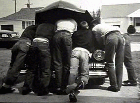Before one can properly select a lubricant for a specific application
some basic theory must be understood. When one surface moves over
another there is always some degree of resistance to movement. This
resistance to movement is called friction. Friction can manifest
itself in varying degrees from smooth easy sliding to uneven erratic
movement, which can generate excessive heat and cause damage to the
moving surfaces.
Friction is good when it causes the brakes and tires on cars and
trucks to stop the vehicle or when it keeps our shoes from slipping on
wet surfaces, yet friction is bad when it causes heat, wear and
reduced energy in an engine, gearbox, transmission or piece of
equipment.
Lubrication is simply the use of a material to improve the smoothness
of movement by reducing friction. The immediate result is reduced
wear and reduced heat generation. There are numerous types of
lubricants but for this book the main consideration is synthetic and
petroleum motor oils, ATF and gear lubes as related to automotive,
motorcycles, recreational vehicles and other equipment.
The coefficient of friction between two moving materials is defined as
mu and changes with load and speed. The force needed to start the
movement is defined as static friction and is typically always greater
than the dynamic friction, which is the force required to keep the two
materials moving at the same speed once initial movement has started.
Different oils and different materials and loading conditions can
create vastly different coefficients of friction that can affect
performance and longevity of an engine and other mechanical
components. A few basic key functions of a motor oil is to reduce
friction under all extremes of operating condition, prevent corrosion
of internal engine components and provide for cooling via transfer of
heat.
When it comes to reducing friction (as well as preventing corrosion
and providing effective heat transfer) I am a firm believer in
synthetic lubrication. Here's the basics of why I say that: when
using a petroleum oil, under certain conditions, the lubricant film
can be either too thin, thus allowing metal-to-metal contact, or too
viscous which causes high internal friction within the layers of the
oil. The key is to select an oil that is thin enough to have a low
internal friction coefficient, yet still high enough to effectively
separate two metal surfaces under all operational conditions and
prevent excessive wear and heat generation. The facts prove that
synthetic lubrication achieves both of these objectives while with
petroleum oil there can be a compromise. The uniform molecular
structure of synthetic lubricants allow it to flow freely for low
internal friction, yet still effectively separate two metal-to-metal
contact surfaces under normal and extreme operating conditions and
significantly reduce internal wear.
When you look at two metal surfaces, such as piston to cylinder, and
visually see that they appear smooth what you are seeing does not
accurately reflect reality. When viewed under a high-powered
microscope even the smoothest machined surfaces are rough and are
viewed as millions of peaks and valleys. These peaks are under
extremely high loading and need to wear-in (commonly called break-in)
on a new engine. However, there is much discrepancy among automotive
and motorsport enthusiasts as to how long of a time period is required
for engine wear-in and whether or not petroleum oil must be used for
the initial wear-in.
The time required for wear-in, before converting to synthetic oil, on
a new production manufactured engine is very minimal and typically
occurs during the hot run test at the engine manufacturer and also on
the chassis rolls in the assembly plant, while driving the vehicle
around the storage yard, railhead, dealers lot and test drives.
Babying a new production car for many thousands of miles to "break it
in" is no longer necessary, as it was many years ago. There are also a
few models of high performance production vehicles that come factory
fill with synthetic oil, further verifying the fact that petroleum oil
is not required to wear-in an engine.

